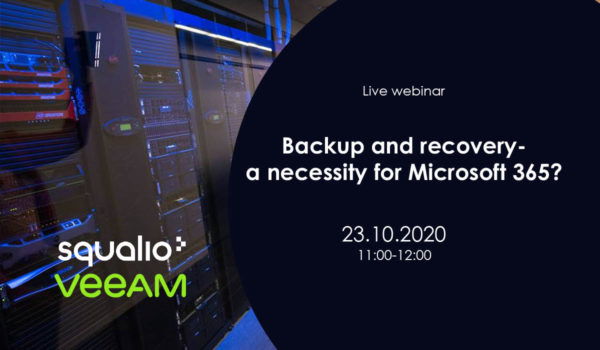Everything you need to know about buying modern backup
The need for modern backup
First let’s start with, “why?” Why now, and why do you need to change? Well most of the time it’s a disruption that is causing the need to change. IT is changing so dramatically, and developers and app owners are finding so many new ways of meeting customer and company needs. With that comes a need to find flexibility in our data protection systems, to support new platforms, multi-clouds, fabric and data types. And it very quickly gets to a point that current backup systems are not able to cope, and we are spending far too much time and resources to make them flex unnaturally. However, many feel the risk of moving to a new solution outweighs the spiraling cost to the company of the current one. So, let’s talk about risk.
Why modern backup?
We sometimes just deal with problems, as the discomfort of change can feel overwhelming. Modernizing backup is the same process. We know we want to do it, we know it will save time and budget while being able to support anything new thrown its way, but we hesitate as a new system comes with risk. The risk of purchasing the right one, deployment risks, and migration risks. So what’s the best way to do this?
- Comprehensive protection. Forrester recommends you seek out backup solutions and vendors that can protect the myriad workloads in a unified manner as organizations evolve beyond on-premises data centers to leverage multiple cloud services like AWS and Azure, while maintaining increasingly heterogeneous infrastructure.
- Recovery at scale. Forrester states that the bottom line of any backup solution is how reliably it can operate under different situations and if its recoveries can meet the needs of the business. The buyers’ guide recommends that organizations search for a solution that can automatically perform background recovery tests to ensure that recovery can happen when you really need it.
- Ease of management. The Forrester guide describes how managing backup operations should not add to the existing complexity with which IT administrators struggle today. Understanding the health, performance and capacity characteristics of the backup infrastructure is critical for day-to-day operations, capacity planning and long-term operational strategy.
- Automation and orchestration. Forrester recommends that IT teams should look for policy-driven data protection solutions that can affect the changes automatically. IT teams need modern data protection solutions that can integrate with IT orchestration tools such that workflows can execute backup tasks automatically.
- Data reuse and insights. The Forrester guide explains how the ROI of a modern backup solution comes not just from the assurance of recoverability but also from the ability to do more by leveraging the data within the backup repositories for any other business use beyond “just” retention or recovery.
- Security. Forrester recommends that organizations must secure the systems and data as part of their cybersecurity strategies. They point out that backups are essential, but it’s also important that the backup itself doesn’t get infected. Enterprises are susceptible to unexpected downtimes, but they may also be vulnerable to cyberthreats. These malicious attacks seek to disrupt businesses by attacking data or even holding it ransom.
How Veeam can help?
A modern backup solution must work seamlessly with on-premises servers and the cloud, provide a comprehensive and easy-to-use platform to better handle complex data, and guarantee data will be available when and where it is needed. So where can Veeam help? Let’s take a tour on how Veeam would approach these six core criteria.
Comprehensive protection
Veeam answers the call for comprehensive protection by providing one platform that enables users to create backups, snapshots and replications for entire production data sets and the ability to transport data easily between platforms, regardless of where the data resided last month, this month, or next. It integrates with diverse storage platforms for snapshots and replications within the same data protection management framework, and supports modern workloads, such as NAS, distributed file systems, unstructured data and cloud-based data services.
Recovery at scale
Veeam ensures recoverability in several ways, but most notably by recovering your data within a secure “sandbox” and then confirming that the application started, the files exist, etc.
Ease of management
Veeam has always been known for its ease-of-use, and has worked to help users reduce operational burden during daily monitoring or ongoing backups and create easier and more accurate restores. Using Veeam Explorer for Microsoft Exchange to recover from on-premises Exchange Servers and cloud-hosted Office 365 services with the same experience. Similar capabilities are offered for administrators of Microsoft SQL Server or Oracle, Active Directory, SharePoint, etc.
Automation and orchestration
Veeam is proven to be easy-to-use for simple recoveries and enables orchestrated recoveries of complex (e.g. multi-layer) applications.
Veeam orchestrations can support different types of workloads too. You can also leverage orchestration for Veeam backups, replicas and third party array-based replication.
Data reuse and insights
One way that Veeam improves customer ROI is by enabling data reuse and re-hosting entire VMs or exposing individual storage volumes to secondary processes:
- Enable regulatory auditors’ access to data without affecting production
- Enable data mining and reporting from secondary data repositories
- Accelerate DevOps by providing a safe and updated copy of production data to develop new applications against
- Enhance cybersecurity preparedness and quarantine during backup and recovery processes
Security
Veeam enables customers to follow the 3-2-1 Rule, so your data isn’t susceptible to infection. That rule is to keep at least three copies of data stored on two different media with one of them off site. Veeam also offers extensive recovery protection using backup immutability from ransomware. This locks backup data that can be stored on premises, AWS or Azure from malicious attacks or encryption. This guarantees that if production data is compromised, restoration can be ensured.
So to wrap this all up, while the subject of modern backup can be wide, the tenants for a modern approach to data protection and data management can be narrowed to make it easier to tackle. You need to be asking yourself how you fare today with your current backup solution and ensure that you are holding any new solutions that you are considering to this list.

ARE YOU INTERESTED IN IMPROVING YOUR PRODUCTIVITY?



